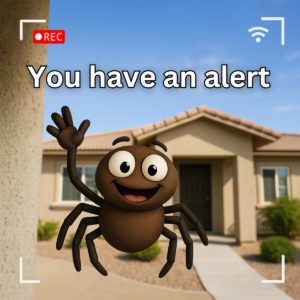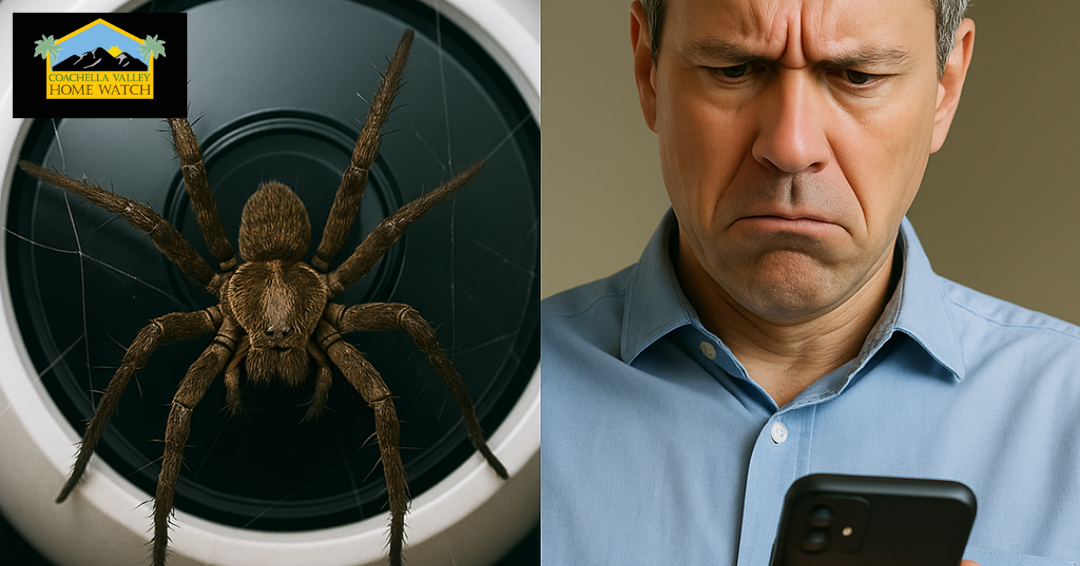If your motion-activated security camera is sending frequent alerts when no one is there, you’re not alone. Many homeowners and snowbirds in the Coachella Valley are surprised (and sometimes frustrated) to learn that even something as small as a fly or spider can trigger these systems. While home security is crucial, especially when you’re away, false alarms can lead to anxiety, wasted time, or even ignoring real alerts.
This article will explain how and why motion cameras are triggered by tiny insects, what it means for your property’s safety, and how a professional home watch service can help you stay protected without the stress of constant false alerts.
How Motion Cameras Work (And Why They Overreact)
Motion Detection 101
Most motion-activated cameras use one of the following technologies:
- Passive Infrared (PIR) sensors, which detect changes in heat.
- Video-based analytics, which look for movement or pixel changes in the camera’s field of view.
- Dual-sensor cameras, which combine both for more accurate detection.
The challenge? These systems don’t discriminate between a person and a spider crawling across the lens. In fact, even a tiny shadow shift caused by a flying insect or dust particle can result in a motion alert, especially in bright sunlight or during temperature fluctuations.
Real-World Example: A Spider Triggering Daily Alerts

Louis Moreto, co-owner of Coachella Valley Home Watch, recalls a client who received daily alerts from her vacation home’s security system. After reviewing the footage, it became clear—a spider had spun a web across the lens. Every time the web moved or the spider crawled by, the motion sensor lit up.
“The homeowner was convinced someone was walking around her patio at night. But when we checked, it was a spider on the camera—nothing more,” Louis explains.
“We cleaned the lens, adjusted the camera angle, and she stopped getting alerts unless it was something real.”
Why This Is a Bigger Deal Than You Think
The Risks of False Positives
While a bug-triggered camera may seem like a minor inconvenience, it has bigger implications:
- Alert fatigue: Too many false alarms lead homeowners to ignore real ones.
- Battery drain: Wireless cameras can lose charge faster if they’re recording constantly.
- Cloud storage limits: Frequent recordings fill up storage, causing you to miss important footage.
- Privacy concerns: Constant footage uploads could create cybersecurity risks if the camera is connected to Wi-Fi.
Why It Happens More in the Coachella Valley
The desert climate brings a mix of extreme heat, insects, and dry air—all of which contribute to this issue:
- High insect activity: Flies and spiders are especially active around outdoor lighting and shaded camera housings.
- Thermal shifts: Hot daytime temps followed by cool nights cause infrared sensors to behave erratically.
- Dust particles: Blowing sand or dust can reflect sunlight and appear as “movement” in camera footage.
What You Can Do: Smart Fixes for Smarter Cameras
1. Clean the Camera Lens Regularly
Dust, cobwebs, and insect residue can all distort the camera’s view or trick sensors. Use a microfiber cloth and gentle cleaner monthly.
2. Adjust Sensitivity Settings
Many smart cameras allow you to reduce motion sensitivity or ignore movement in specific zones.
3. Reposition the Camera
Mount cameras in well-lit, open areas away from lights that attract bugs. Avoid mounting directly under eaves or near planters.
4. Install Insect-Repellent Housings
You can purchase third-party camera covers or apply natural deterrents like peppermint oil near the camera housing to repel insects.
5. Use a Professional Home Watch Service
Even the best security system benefits from on-site human inspection. Coachella Valley Home Watch combines smart home tech with in-person visits to verify alerts and ensure your home is truly secure.
FAQ: Solving the Mystery of Security Camera Alerts

Can a spider really trigger a security camera?
Absolutely—and it’s more common than most people realize. Spiders often build webs directly in front of outdoor security cameras because the housing provides a quiet, sheltered space. As the spider moves across the lens or its web sways in the wind or reflects light, motion sensors—especially video-based or infrared ones—detect this activity and record it as a “motion event.” Some cameras may even zoom in or follow the movement, mistaking the tiny motion for a person or animal. If you’re getting frequent alerts and seeing blurry or stringy images in the footage, a spider could be the culprit.
Why do I get alerts when nothing is there?
Frequent false alerts are typically caused by environmental factors that confuse motion sensors. These include insects flying close to the lens, shadows moving due to wind-blown trees, headlights flashing in the distance, or even changes in sunlight throughout the day. Infrared sensors are especially sensitive to heat differences, so if a warm breeze or sunbeam hits just right, it can trip the system. Dust, pollen, and reflections from windows or water surfaces can also appear as “movement” to your camera. In short, your camera is doing its job—it’s just interpreting the wrong kind of activity.
What’s the best way to stop false alerts?
The most effective way to reduce false motion alerts is a combination of camera maintenance, strategic placement, and smart technology settings. Start by cleaning your camera lens regularly to remove dust, cobwebs, and bug residue. Next, check the camera’s location—avoid placing it too close to lights, plants, or areas that attract bugs. Most smart cameras allow you to adjust sensitivity settings, create activity zones, or enable “person detection” modes, which can drastically reduce false positives. For added peace of mind, consider hiring a professional home watch service like Coachella Valley Home Watch to inspect your property and review camera footage in person. We often identify small issues—like spider webs or a poorly angled camera—that homeowners may overlook.
Should I turn off motion detection while I’m away?
It’s not recommended. Motion detection is one of your best tools for real-time alerts and video evidence if something truly suspicious happens. Instead of turning it off completely, fine-tune the system to work smarter. Most modern cameras let you adjust motion zones, set alert schedules, or filter for specific types of activity (like people or vehicles only). These features can help reduce false alarms without compromising your home’s security. And if you’re a seasonal resident or snowbird, partnering with a trusted home watch provider ensures there’s someone on the ground to verify whether alerts are real or harmless.
Trust the Experts at Coachella Valley Home Watch
You deserve peace of mind—whether you’re at home or thousands of miles away. At Coachella Valley Home Watch, we blend technology with personal care. Our trained professionals conduct thorough property inspections, verify camera alerts, and help keep your desert home secure.
Don’t let bugs or shadows fool your security system. Get the clarity and confidence you need.
👉 Contact Coachella Valley Home Watch today to schedule a free consultation and learn how we can protect your home—smarter, safer, and stress-free. 760-205-2072


